Industrial Applications of Boiling and Evaporation System
VerifiedAdded on 2023/05/30
|7
|1095
|475
AI Summary
This article discusses the industrial applications of boiling and evaporation system, including heat pump, wastewater treatment, cooling of buildings, drying in post-harvest system, and mechanical vapor recompression. The article explains how these systems are used in different sectors and how they contribute positively to various industrial applications.
Contribute Materials
Your contribution can guide someone’s learning journey. Share your
documents today.

Name of the Student
Name of the Professor
City/State
Date/Month/Year
Name of the Professor
City/State
Date/Month/Year
Secure Best Marks with AI Grader
Need help grading? Try our AI Grader for instant feedback on your assignments.
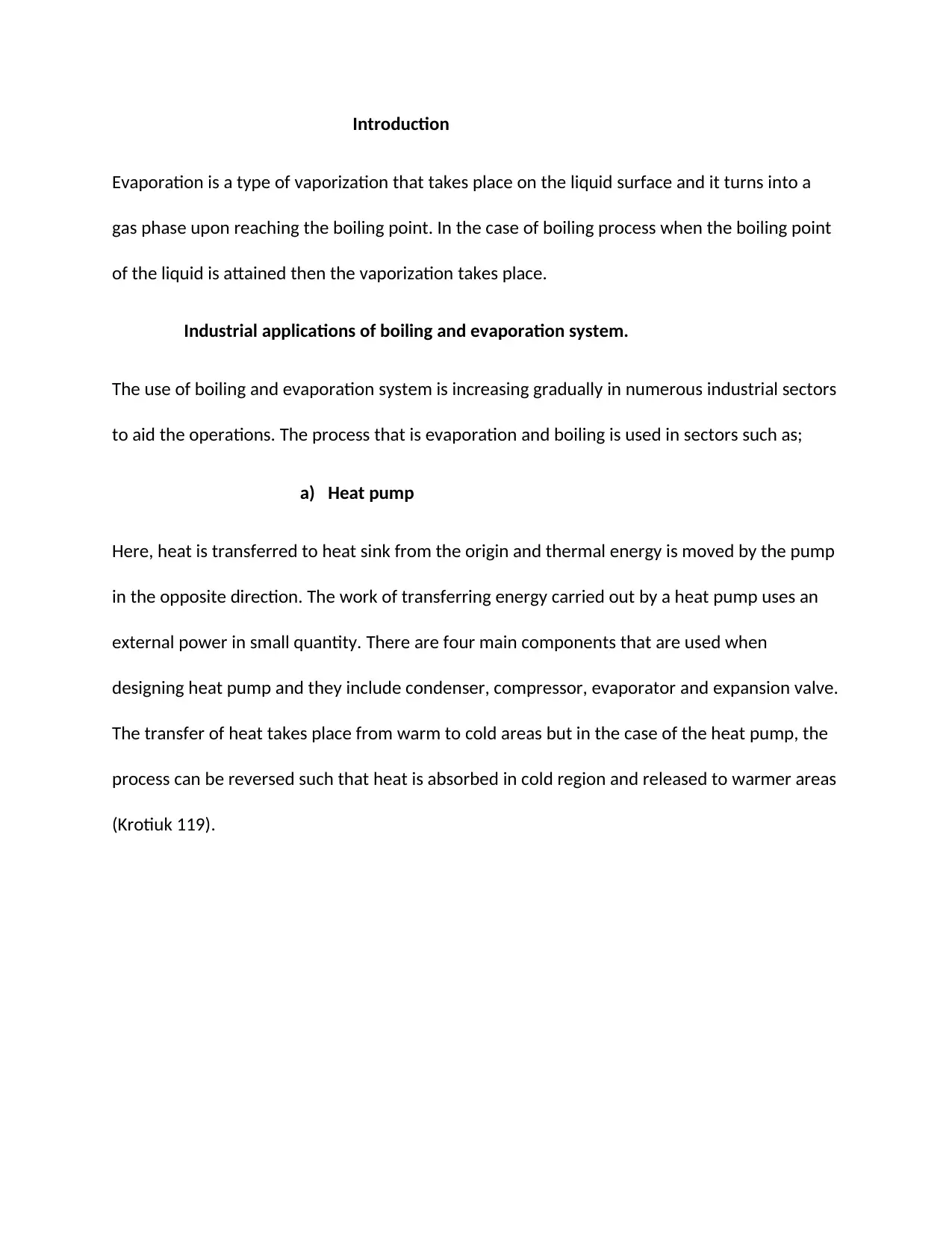
Introduction
Evaporation is a type of vaporization that takes place on the liquid surface and it turns into a
gas phase upon reaching the boiling point. In the case of boiling process when the boiling point
of the liquid is attained then the vaporization takes place.
Industrial applications of boiling and evaporation system.
The use of boiling and evaporation system is increasing gradually in numerous industrial sectors
to aid the operations. The process that is evaporation and boiling is used in sectors such as;
a) Heat pump
Here, heat is transferred to heat sink from the origin and thermal energy is moved by the pump
in the opposite direction. The work of transferring energy carried out by a heat pump uses an
external power in small quantity. There are four main components that are used when
designing heat pump and they include condenser, compressor, evaporator and expansion valve.
The transfer of heat takes place from warm to cold areas but in the case of the heat pump, the
process can be reversed such that heat is absorbed in cold region and released to warmer areas
(Krotiuk 119).
Evaporation is a type of vaporization that takes place on the liquid surface and it turns into a
gas phase upon reaching the boiling point. In the case of boiling process when the boiling point
of the liquid is attained then the vaporization takes place.
Industrial applications of boiling and evaporation system.
The use of boiling and evaporation system is increasing gradually in numerous industrial sectors
to aid the operations. The process that is evaporation and boiling is used in sectors such as;
a) Heat pump
Here, heat is transferred to heat sink from the origin and thermal energy is moved by the pump
in the opposite direction. The work of transferring energy carried out by a heat pump uses an
external power in small quantity. There are four main components that are used when
designing heat pump and they include condenser, compressor, evaporator and expansion valve.
The transfer of heat takes place from warm to cold areas but in the case of the heat pump, the
process can be reversed such that heat is absorbed in cold region and released to warmer areas
(Krotiuk 119).
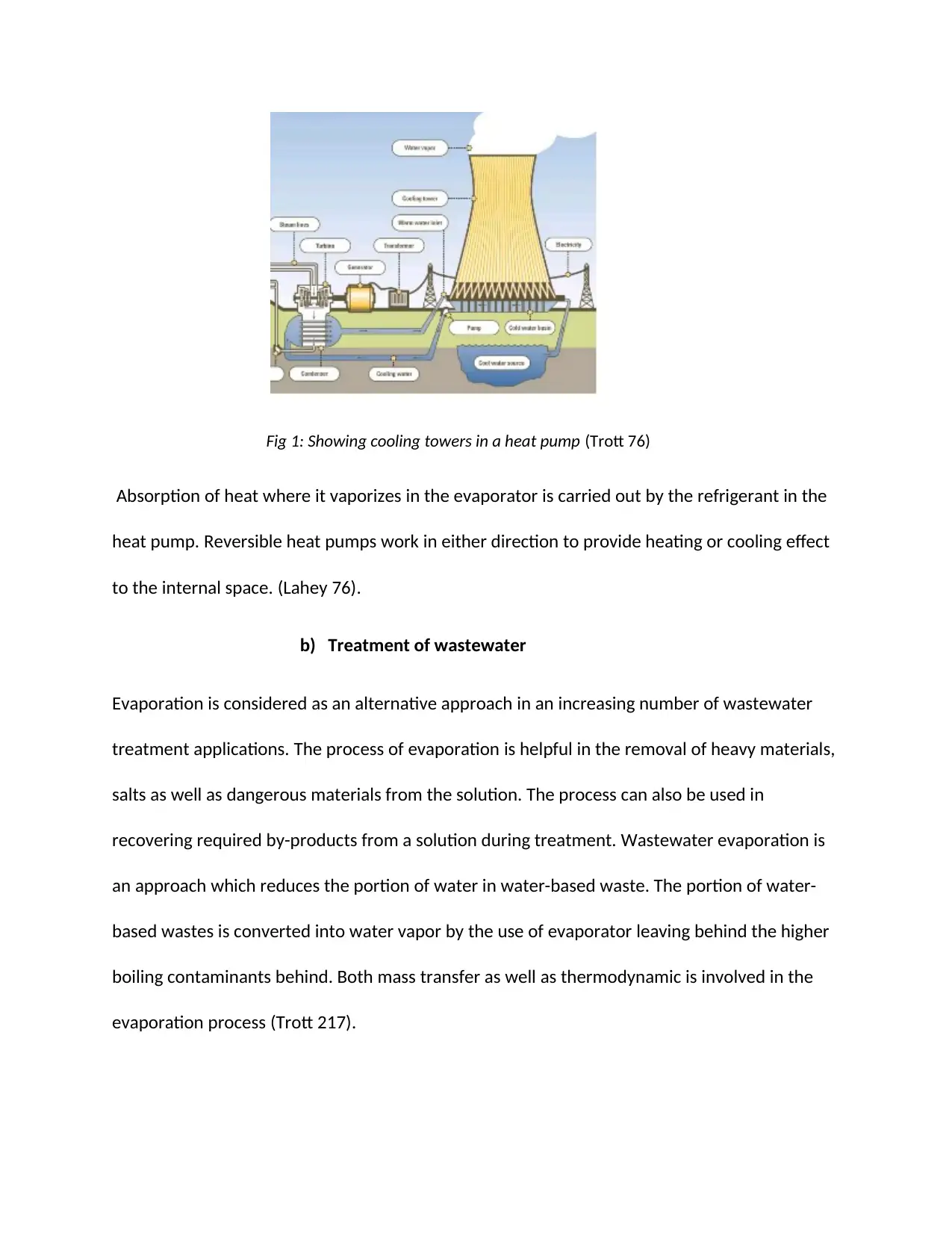
Fig 1: Showing cooling towers in a heat pump (Trott 76)
Absorption of heat where it vaporizes in the evaporator is carried out by the refrigerant in the
heat pump. Reversible heat pumps work in either direction to provide heating or cooling effect
to the internal space. (Lahey 76).
b) Treatment of wastewater
Evaporation is considered as an alternative approach in an increasing number of wastewater
treatment applications. The process of evaporation is helpful in the removal of heavy materials,
salts as well as dangerous materials from the solution. The process can also be used in
recovering required by-products from a solution during treatment. Wastewater evaporation is
an approach which reduces the portion of water in water-based waste. The portion of water-
based wastes is converted into water vapor by the use of evaporator leaving behind the higher
boiling contaminants behind. Both mass transfer as well as thermodynamic is involved in the
evaporation process (Trott 217).
Absorption of heat where it vaporizes in the evaporator is carried out by the refrigerant in the
heat pump. Reversible heat pumps work in either direction to provide heating or cooling effect
to the internal space. (Lahey 76).
b) Treatment of wastewater
Evaporation is considered as an alternative approach in an increasing number of wastewater
treatment applications. The process of evaporation is helpful in the removal of heavy materials,
salts as well as dangerous materials from the solution. The process can also be used in
recovering required by-products from a solution during treatment. Wastewater evaporation is
an approach which reduces the portion of water in water-based waste. The portion of water-
based wastes is converted into water vapor by the use of evaporator leaving behind the higher
boiling contaminants behind. Both mass transfer as well as thermodynamic is involved in the
evaporation process (Trott 217).
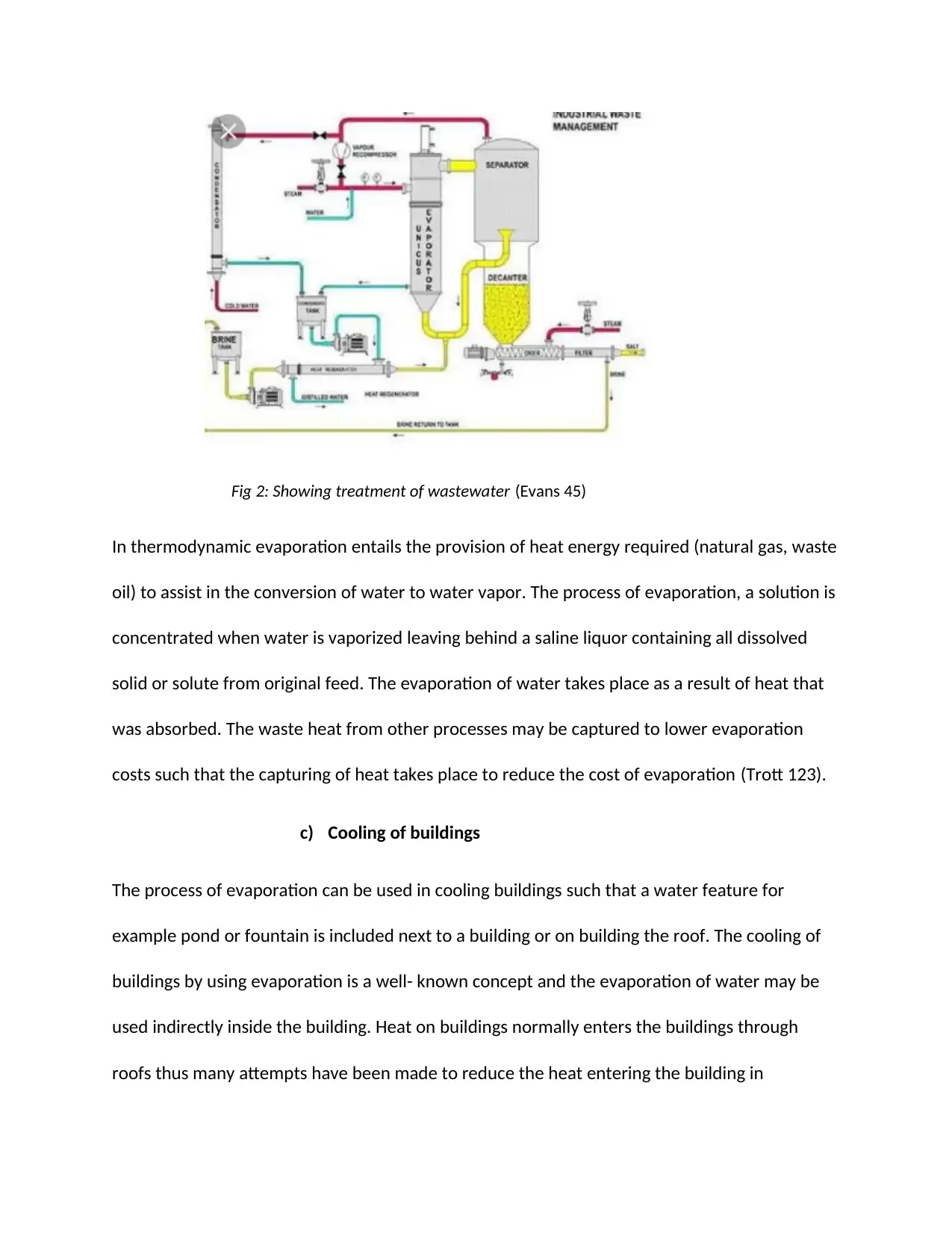
Fig 2: Showing treatment of wastewater (Evans 45)
In thermodynamic evaporation entails the provision of heat energy required (natural gas, waste
oil) to assist in the conversion of water to water vapor. The process of evaporation, a solution is
concentrated when water is vaporized leaving behind a saline liquor containing all dissolved
solid or solute from original feed. The evaporation of water takes place as a result of heat that
was absorbed. The waste heat from other processes may be captured to lower evaporation
costs such that the capturing of heat takes place to reduce the cost of evaporation (Trott 123).
c) Cooling of buildings
The process of evaporation can be used in cooling buildings such that a water feature for
example pond or fountain is included next to a building or on building the roof. The cooling of
buildings by using evaporation is a well- known concept and the evaporation of water may be
used indirectly inside the building. Heat on buildings normally enters the buildings through
roofs thus many attempts have been made to reduce the heat entering the building in
In thermodynamic evaporation entails the provision of heat energy required (natural gas, waste
oil) to assist in the conversion of water to water vapor. The process of evaporation, a solution is
concentrated when water is vaporized leaving behind a saline liquor containing all dissolved
solid or solute from original feed. The evaporation of water takes place as a result of heat that
was absorbed. The waste heat from other processes may be captured to lower evaporation
costs such that the capturing of heat takes place to reduce the cost of evaporation (Trott 123).
c) Cooling of buildings
The process of evaporation can be used in cooling buildings such that a water feature for
example pond or fountain is included next to a building or on building the roof. The cooling of
buildings by using evaporation is a well- known concept and the evaporation of water may be
used indirectly inside the building. Heat on buildings normally enters the buildings through
roofs thus many attempts have been made to reduce the heat entering the building in
Secure Best Marks with AI Grader
Need help grading? Try our AI Grader for instant feedback on your assignments.
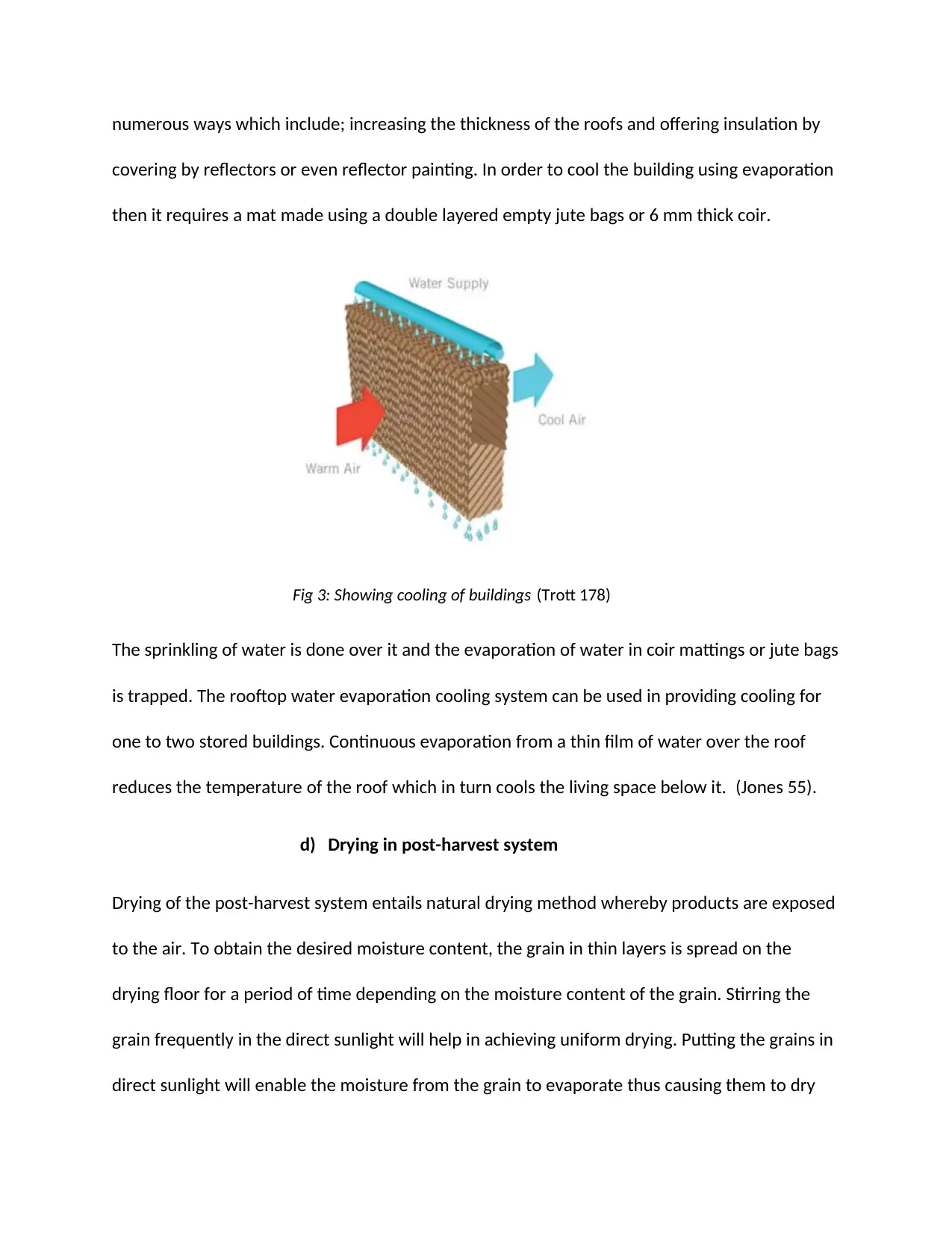
numerous ways which include; increasing the thickness of the roofs and offering insulation by
covering by reflectors or even reflector painting. In order to cool the building using evaporation
then it requires a mat made using a double layered empty jute bags or 6 mm thick coir.
Fig 3: Showing cooling of buildings (Trott 178)
The sprinkling of water is done over it and the evaporation of water in coir mattings or jute bags
is trapped. The rooftop water evaporation cooling system can be used in providing cooling for
one to two stored buildings. Continuous evaporation from a thin film of water over the roof
reduces the temperature of the roof which in turn cools the living space below it. (Jones 55).
d) Drying in post-harvest system
Drying of the post-harvest system entails natural drying method whereby products are exposed
to the air. To obtain the desired moisture content, the grain in thin layers is spread on the
drying floor for a period of time depending on the moisture content of the grain. Stirring the
grain frequently in the direct sunlight will help in achieving uniform drying. Putting the grains in
direct sunlight will enable the moisture from the grain to evaporate thus causing them to dry
covering by reflectors or even reflector painting. In order to cool the building using evaporation
then it requires a mat made using a double layered empty jute bags or 6 mm thick coir.
Fig 3: Showing cooling of buildings (Trott 178)
The sprinkling of water is done over it and the evaporation of water in coir mattings or jute bags
is trapped. The rooftop water evaporation cooling system can be used in providing cooling for
one to two stored buildings. Continuous evaporation from a thin film of water over the roof
reduces the temperature of the roof which in turn cools the living space below it. (Jones 55).
d) Drying in post-harvest system
Drying of the post-harvest system entails natural drying method whereby products are exposed
to the air. To obtain the desired moisture content, the grain in thin layers is spread on the
drying floor for a period of time depending on the moisture content of the grain. Stirring the
grain frequently in the direct sunlight will help in achieving uniform drying. Putting the grains in
direct sunlight will enable the moisture from the grain to evaporate thus causing them to dry
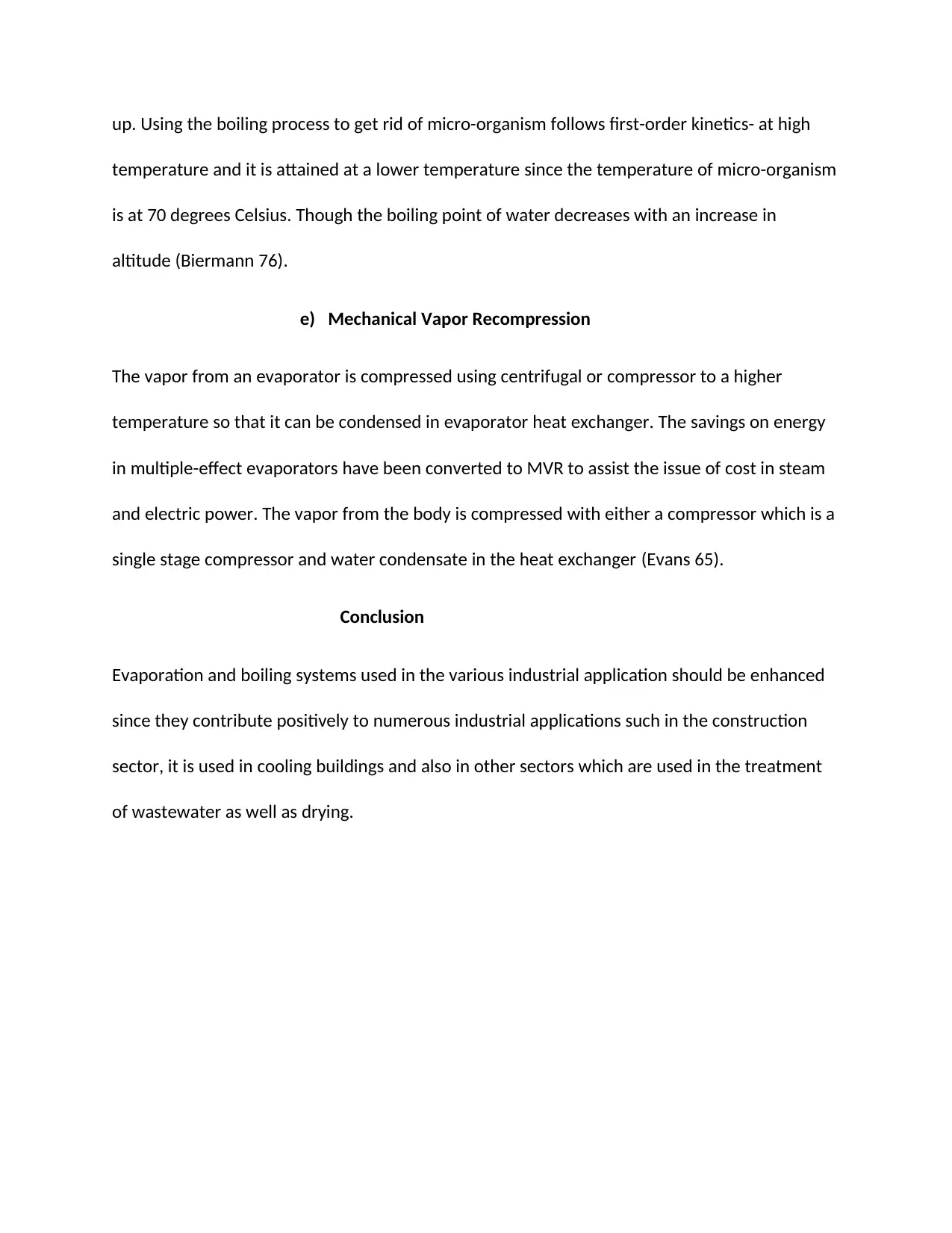
up. Using the boiling process to get rid of micro-organism follows first-order kinetics- at high
temperature and it is attained at a lower temperature since the temperature of micro-organism
is at 70 degrees Celsius. Though the boiling point of water decreases with an increase in
altitude (Biermann 76).
e) Mechanical Vapor Recompression
The vapor from an evaporator is compressed using centrifugal or compressor to a higher
temperature so that it can be condensed in evaporator heat exchanger. The savings on energy
in multiple-effect evaporators have been converted to MVR to assist the issue of cost in steam
and electric power. The vapor from the body is compressed with either a compressor which is a
single stage compressor and water condensate in the heat exchanger (Evans 65).
Conclusion
Evaporation and boiling systems used in the various industrial application should be enhanced
since they contribute positively to numerous industrial applications such in the construction
sector, it is used in cooling buildings and also in other sectors which are used in the treatment
of wastewater as well as drying.
temperature and it is attained at a lower temperature since the temperature of micro-organism
is at 70 degrees Celsius. Though the boiling point of water decreases with an increase in
altitude (Biermann 76).
e) Mechanical Vapor Recompression
The vapor from an evaporator is compressed using centrifugal or compressor to a higher
temperature so that it can be condensed in evaporator heat exchanger. The savings on energy
in multiple-effect evaporators have been converted to MVR to assist the issue of cost in steam
and electric power. The vapor from the body is compressed with either a compressor which is a
single stage compressor and water condensate in the heat exchanger (Evans 65).
Conclusion
Evaporation and boiling systems used in the various industrial application should be enhanced
since they contribute positively to numerous industrial applications such in the construction
sector, it is used in cooling buildings and also in other sectors which are used in the treatment
of wastewater as well as drying.
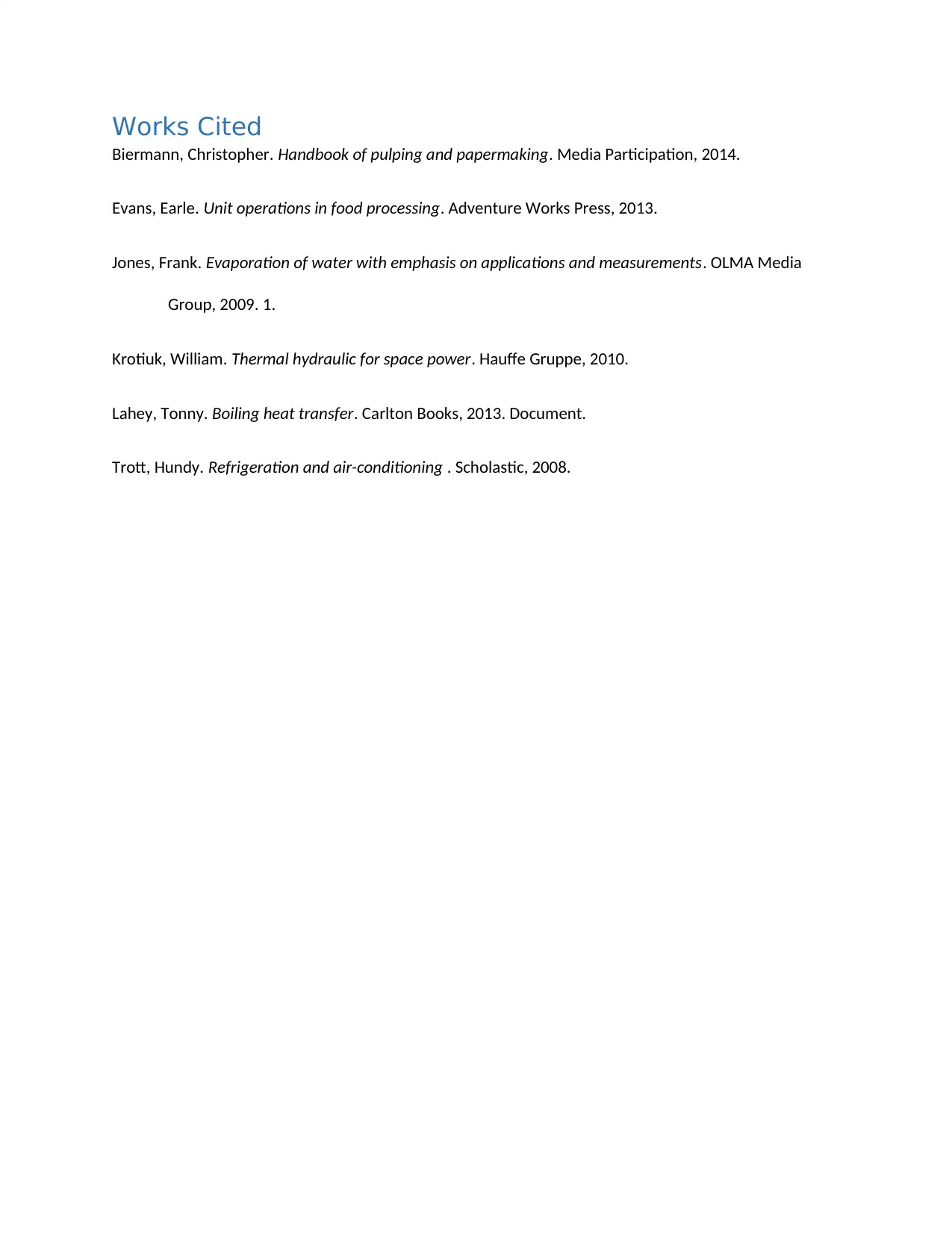
Works Cited
Biermann, Christopher. Handbook of pulping and papermaking. Media Participation, 2014.
Evans, Earle. Unit operations in food processing. Adventure Works Press, 2013.
Jones, Frank. Evaporation of water with emphasis on applications and measurements. OLMA Media
Group, 2009. 1.
Krotiuk, William. Thermal hydraulic for space power. Hauffe Gruppe, 2010.
Lahey, Tonny. Boiling heat transfer. Carlton Books, 2013. Document.
Trott, Hundy. Refrigeration and air-conditioning . Scholastic, 2008.
Biermann, Christopher. Handbook of pulping and papermaking. Media Participation, 2014.
Evans, Earle. Unit operations in food processing. Adventure Works Press, 2013.
Jones, Frank. Evaporation of water with emphasis on applications and measurements. OLMA Media
Group, 2009. 1.
Krotiuk, William. Thermal hydraulic for space power. Hauffe Gruppe, 2010.
Lahey, Tonny. Boiling heat transfer. Carlton Books, 2013. Document.
Trott, Hundy. Refrigeration and air-conditioning . Scholastic, 2008.
1 out of 7
Related Documents
Your All-in-One AI-Powered Toolkit for Academic Success.
+13062052269
info@desklib.com
Available 24*7 on WhatsApp / Email
![[object Object]](/_next/static/media/star-bottom.7253800d.svg)
Unlock your academic potential
© 2024 | Zucol Services PVT LTD | All rights reserved.



